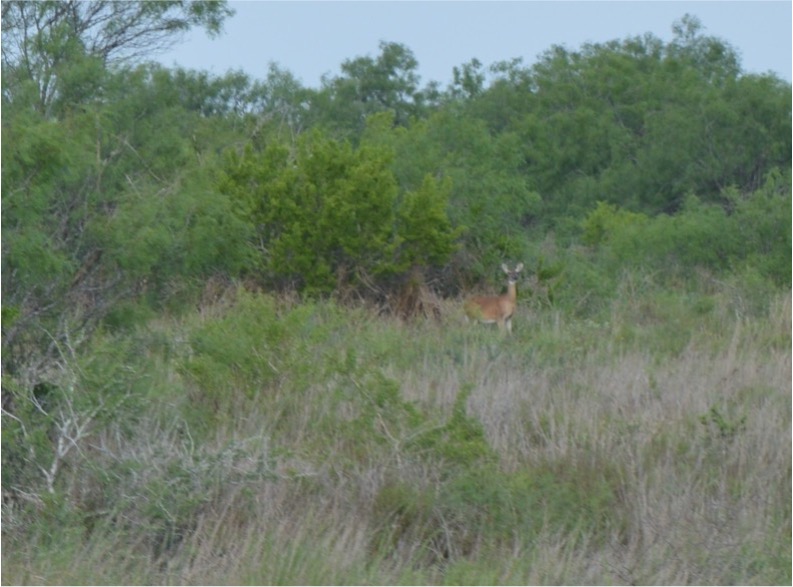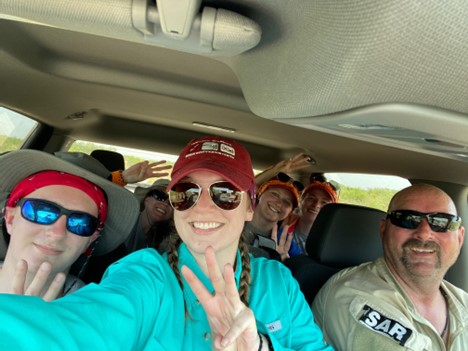
Ready to Go
Today was by far the most grueling work day so far. We definitely made up for the work we missed yesterday. Although we had a great time at the cookout last night, we lost a few hours of much needed rest. Nevertheless, we were up and ready to go by 7 am…well actually by “we” I mean just the girls. I had to fight to get out of bed and was barely awake for the car ride to the search location. Fortunately, I haven’t felt any muscle soreness, but my legs felt incredibly weak. On top of that I skipped my morning coffee, so I was already priming myself for a rough day. The only thing keeping me going is constantly reminding myself why we are here and the difference our team is making in Brooks County.

All Smiles
The day started off with team breakfast as usual. It’s been years since I’ve had frosted flakes. A good sugar rush definitely helped wake me up a bit. After that we were out on the road again, traveling to new GPS coordinates suggesting the last known location of a missing individual. The ride was short and we parked Sandy outside the entrance to the ranch (we weren’t going to risk her off-road capabilities again). The drive in was fun though. Me, Izzy, Olivia, and Jordan hopped in the back of Ray’s truck for a VERY bumpy ride. We spotted some deer and a herd of wild pigs that I just managed to miss snapping a pic of.

Oh Dear
The terrain on this ranch was extremely difficult to navigate. There was so much dead, overgrown grass that completely covered the dirt below. This made our searches extremely difficult and walking very taxing. I think I speak for the rest of the group when I say that this search really beat us up. Today was my new record for how much water I consumed on the job. I drank two full camelbacks (4 liters total), a full 32 oz travel bottle, as well as a 20 oz regular plastic bottle. Needless to say, I was thirsty.

A Break in the Brush
Despite the difficult terrain, this search was probably our most successful in terms of finding evidence of human travel. We found plenty of water bottles, trash bags, and food wrappers. More importantly though, We found a blue backpack and a sweatshirt that seemed to be in new condition, suggesting that these items were recently discarded. This may not seem like much, however, the photos of these items can be used to potentially help identify who was traveling along the route we searched, if they can be recognized by the family of the individual from the GPS coordinates. We have to remember that sometimes our progress is all about perspective. We don’t know if the individual is still out there. They could have moved on or may still be missing. But that small finding could mean a world of difference to the family that has no idea what happened to their loved one. Sometimes all we can do is contribute just a small part of the story, but at least it has the potential to make a difference in the perspective of the family of the missing.

Recent Clothes
Our day ended not long after reaching a new search location on the same ranch. By this time it had already been our longest day in the field this trip, with the temperature reaching 97 degrees fahrenheit (with the high humidity the “feels like” temperature was well over 100) while we were out in the field. Unfortunately, the heat got the best of us. Progress on the search was made, but not long before the team had to get benched with the search getting called off. All of the students had elevated heart rates. Thankfully, we had Ray and Don to take care of us and remind us that although we are on a mission, our safety is a priority as well. What I like about this team is that we all want to push ourselves to our limits and care for one another like a good team should. However, today was a friendly reminder to listen to our own bodies and protect our own health too. We decided that it would be most efficient to quit now and resume the search in the morning when we are well rested and ready to tackle the task head on. In about an hour we were all fine and healthy.

Whatever it Takes
The work day concluded with a much needed shower/nap combo. We went to Strickland’s for dinner where I ended my meal with a refreshing hot coffee. I haven’t had hot coffee in a week and I didn’t realize just how much I missed it. Love me a steaming hot cup o’ joe that just instantly reminds me of home.

To Walk A Mile In Someone Else’s Shoes
This work is extremely tough on the body. Everyday I try to put myself in the shoes of the people who make this excruciating journey in search for a better life. With little resources and everything against you, it is proof of how one’s willpower and determination can push you to incredible lengths. Our week is quickly coming to an end with our last day in the field tomorrow. One thing is for sure though, I do not have to hope for a good outcome. I have faith in my team that we will finish out our week strong.
–Austin

Day 5 Complete!

Ray’s Little Buddy

I Don’t Even Know What to Say Here…Izzy With an Animal Pelvis

Decomposition

Happy Don




















